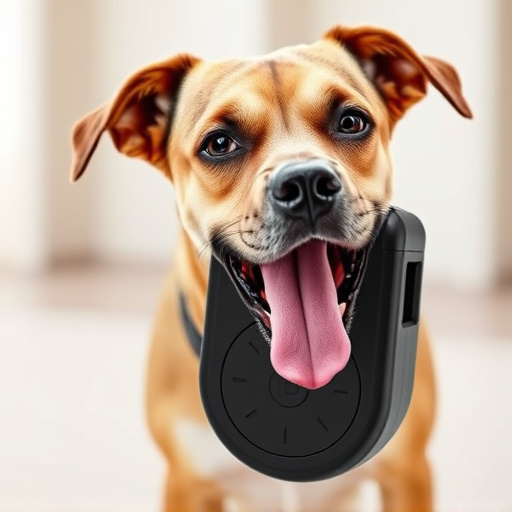Dogs communicate through behaviors and vocalizations, making it vital to understand these cues when considering behavior modification tools like ultrasonic frequency devices. These devices emit inaudible high-frequency sounds to dogs, acting as deterrents for unwanted actions. Handheld devices offer portability for on-the-go training, while wall-mounted units provide continuous reinforcement in specific areas. The choice depends on owner needs: portability vs long-term fixed placement. Ultrasonic repellents are effective for barking and aggression issues but effectiveness varies; incorrect use can cause temporary anxiety. Understanding the differences between handheld and wall-mounted options is key to successful dog behavior modification, requiring clear commands, positive reinforcement, and tailored adjustments.
Introducing the revolutionary Handheld Vs Wall Mounted Ultrasonic Repellent—a tool designed to transform your dog’s behavior through safe, non-invasive technology. This comprehensive guide explores ultrasonic frequencies and their impact on canine behavior, offering insights into how these devices work. We compare handheld and wall-mounted designs, discuss their pros and cons, and provide essential safety considerations. Additionally, discover effective training techniques for optimal results with this innovative dog behavior modification tool.
- Understanding Dog Behavior and Ultrasonic Frequencies
- Handheld vs Wall Mounted: Design and Application
- Pros, Cons, and Safety Considerations
- Training Techniques for Effective Use
Understanding Dog Behavior and Ultrasonic Frequencies
Dogs, like humans, communicate through a variety of behaviors and vocalizations. Understanding these cues is essential when considering behavior modification tools, such as ultrasonic frequency devices. These tools emit high-frequency sound waves that are inaudible to humans but can be detected by dogs, often used as a deterrent for unwanted behaviors like barking or jumping.
When comparing handheld and wall-mounted ultrasonic repellents, the choice largely depends on the specific needs of the owner and their dog’s behavior patterns. Handheld devices offer portability, making them ideal for training sessions on the go or addressing isolated issues. Wall-mounted units, on the other hand, are more discreetly installed and can provide constant reinforcement in specific areas where persistent behavioral problems occur, such as entryways or beds.
Handheld vs Wall Mounted: Design and Application
When considering an ultrasonic frequency dog behavior modification tool, one key factor to explore is the design: handheld versus wall-mounted. Handheld devices offer portability and flexibility, allowing for easy movement around your home or yard. They’re ideal for training sessions on the go, as you can target specific areas where unwanted behaviors occur. Additionally, their compact size makes them convenient to store when not in use.
On the other hand, wall-mounted ultrasonic repellents are designed for more permanent installation. Strategically placed near entry points or problem areas, they provide continuous, unobtrusive deterrence without the need for frequent battery changes. While less portable, their fixed location can be a powerful tool for establishing consistent boundaries and routines, which can significantly impact long-term behavioral modification.
Pros, Cons, and Safety Considerations
Pros:
Ultrasonic frequency dog behavior modification tools have proven effective in addressing various canine issues, such as barking and aggression. These devices emit high-frequency sound waves that are inaudible to humans but can deter dogs from unwanted behaviors. One significant advantage is their portability; handheld models allow for easy use in any environment, including during walks or travel. This flexibility sets them apart from wall-mounted repellents, offering more convenience and versatility for pet owners. Additionally, ultrasonic tools are generally safe and painless, with no known long-term effects on dogs’ hearing or health, making them a non-invasive solution.
Cons:
Despite their benefits, these devices also have drawbacks. The effectiveness of ultrasonic repellents can vary based on the dog’s sensitivity to sound and the specific frequency used. Some dogs might not react at all, while others may become desensitized over time, requiring higher frequencies or different approaches. Furthermore, handheld devices may require frequent manual activation, which could be inconvenient during longer training sessions or when the owner is unable to attend to them immediately. Wall-mounted repellents, though more reliable in specific areas, limit their use and might not address issues that occur outside those spaces. Lastly, while generally safe, incorrect usage or sensitivity differences in dogs can lead to temporary anxiety or discomfort.
Training Techniques for Effective Use
When utilizing an ultrasonic frequency dog behavior modification tool, understanding the difference between handheld and wall-mounted repellents is key to effective training. Handheld devices offer flexibility, allowing for dynamic adjustments during training sessions. They are ideal for correcting specific behaviors like excessive barking or jumping up on command, as you can target these actions precisely where they occur. On the other hand, wall-mounted ultrasonic repelants provide a constant, ambient deterrent, best suited for persistent issues like unwanted marking or roaming.
Training should begin with clear and consistent commands, paired with positive reinforcement when your dog exhibits desired behavior. Gradually increase the intensity of the ultrasonic signal as your dog adapts, ensuring it remains within a range that is audible but not irritating. Differentiating between the handheld and wall-mounted options based on your dog’s specific needs will enhance the tool’s effectiveness in modifying their behavior over time.
The handheld versus wall-mounted ultrasonic repellent debate highlights the diverse needs of dog owners. While both options effectively modify canine behavior through ultrasonic frequencies, understanding their unique advantages is key. Handheld devices offer portability for on-the-go training, ideal for active dogs or outdoor situations. Wall-mounted units, however, provide consistent protection in specific areas, making them suitable for persistent behavioral issues. Ultimately, the best choice depends on individual preferences and dog behavior dynamics, ensuring a calmer, more harmonious living environment.
